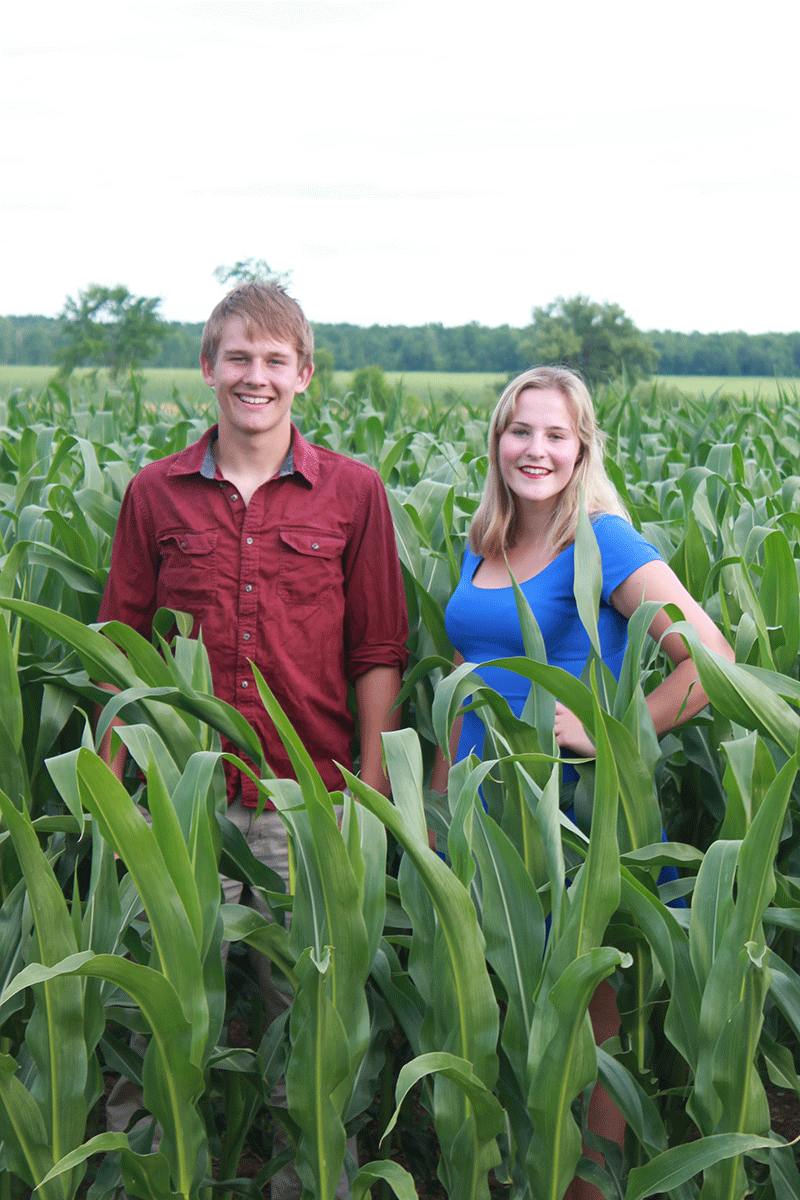An agvocacy lesson
DEFENDING AGRICULTURE IN THE CLASSROOM
“THE PESTICIDES FARMERS are using will cause bees to go extinct in five years.”
PHOTO: BRADEN AND SHYLAH HART.

When Braden and Shylah Hart heard that statement in their grade 9 Issues in Canadian Geography class, it didn’t sit right with them.
“It didn’t make me feel very well to hear my teacher putting down farmers,” says Shylah.
“I knew there was more to the issue,” adds Braden, “I just didn’t have the facts to back me up.”
The Harts, students at Napanee District Secondary School, help their parents with the family business — Hart Acre Grains — which operates an elevator and a cash crop farm growing corn, soybeans, wheat, and canola. So after school, they went to their dad.
“It’s very dangerous if the educators are teaching opinion instead of fact,” says Herb Hart. He helped the twins look up some information online about bee health that was taken to school the next day.
When Braden and Shylah presented this additional information to their teacher, it began a debate about credible scientific sources and the difference between opinions and facts.
“As good geographers we put the inquiry model into action, asking questions and gathering various viewpoints on the issue, and then drawing conclusions,” says Daryl Sheffield, the Hart’s geography teacher, via email.
The subject of bee health came up during a lesson within the Livable Communities unit of the course and a discussion on land use in cities and towns. However, Sheffield explains, “this grade 9 course is a survey of various issues faced by Canadians and thus does not allow time for in-depth study of all issues.”
SOURCING FACTS
Not happy with the way their defense of farming was received by their teacher, Braden and Shylah went home for the weekend with an assignment to provide more sources and facts within an essay that would support their view of the relationship between bee health and grain farming practices. On behalf of his children, Herb reached out to Grain Farmers of Ontario for help with the project, and through the member relations department the Harts were connected with Hugh Simpson, beekeeper proprietor of Osprey Bluffs Honey Company.
Simpson uses his broad following on Twitter to share a balanced view on beekeeping and the challenges faced by beekeepers. He feels it’s important for everyone from students to government policy makers to understand the multiple factors affecting bee health.
“I consider it a responsibility to help Grain Farmers of Ontario inform their membership with accurate information about bee health; and a young person who is enthusiastic about learning and communicating about the subject to their classmates and teachers is compelling because this stakeholder group has an influential role to play in the future of modern agriculture and the health of honey bees,” says Simpson. “The mono-focus on neonicotinoid use has distracted from important issues which, while not as well published, require a great deal of attention and resources for research and management.”
In an email for the Harts, Simpson wrote, “A neonic coated seed is the safest way to deliver a synthetic crop protector. I’ve had bees in grain yards for a long time and see no worse results during corn/ beans/wheat years, as long as I take care of the other management issues.”
Simpson also referenced some of his recent tweets which highlighted current research and scientific arguments that point to numerous factors, such as loss of habitat and diverse forage, affecting bee health. In their essay, the Harts wrote about Varroa mites, viruses, and poor nutrition.
“Our teacher said, if you are passionate about a subject he is open to you challenging an opinion,” says Shylah, but notes she doesn’t feel Sheffield was convinced that farmers are doing their part to protect bees. “He said he had the right to counter our opinion — we said ours and he could say his.”
“I remind students that there is always more than one viewpoint on an issue and to form an opinion means checking all sides and facts and making an informed decision,” says Sheffield. “Their presentation was informative and shed light on one of the factors in the bee health conversation.”
THE VALUE OF EDUCATION
Whether your children attend an urban or rural school, discussions about agriculture don’t frequently occur in classrooms. AgScape (formerly Ontario Agri-Food Education) has created resources for teachers that make it easier to incorporate agriculture and food information in their lessons.
“Agri-food is intricately linked to the environment, health, economy and culture of Canadians,” says Becky Parker, project and partnership strategist for AgScape. “When students understand and value agriculture and food, they can make informed decisions as consumers and support an industry which makes huge contributions to the Canadian economy.”
Parker acknowledges misinformation may be shared in the classroom about agriculture, but says there are great tools, such as the Consumer Trust Model from the Centre for Food Integrity, that can guide parents in responding to situations like the Harts experienced.
“The research shows that you have to highlight shared values with someone before you correct misinformation or start providing facts,” explains Parker. “Parents can model those types of conversations with their children to help them understand how to respond to misinformation effectively, as opposed to getting defensive or defeated.”
This experience was an important lesson in agvocacy for the Harts.
“I learned there is a lot more information you need to look at than just the first website that comes up on the internet. There is a lot more people and facts you have to look at to understand an issue,” says Shylah.
“The most important thing is don’t listen to everything everyone says before you look at the scientific facts,” says Braden.
It’s a lesson Simpson hopes more people will learn.
“We in agriculture are best to use every encounter with those who are willing to listen as an opportunity to share the story and the facts about modern agriculture,” says Simpson. “I hear often about how a neonic ban or restriction will solve the bee health problems, it is one of the myriad of urban myths that is perpetuated by naïveté and sometimes by ideological agendas. As ag stakeholders encounter these obstacles, we must communicate evenly by acknowledging the opposing position and doing our best to help them understand the overwhelmingly positive ag story.”
Herb says he is proud of the way his children handled writing the essay on their own.
“I’m glad that if they don’t agree with what is taught they can stand up and say so. We’ve always encouraged the kids to speak their mind — if they don’t agree with something, dig into it and find out what’s right. I guess they hear myself and their mother speak about farming issues, they are around the elevator, and they know what the business is. They know the dollars that are at stake, they know the hard work that is at stake, they understand that. As far as I am concerned, they are a lot further ahead than I was at 15.”
Parker suggests all producers need to have conversations with their children about their farm practices. “If youth are aware of the efforts you take to protect and nurture the environment, and to produce safe and healthy food, they may be more likely to stand up and say ‘this is what we do on our farm’. Show that you are proud of your profession and your actions, and your children will be too.” •
SCHOOL RESOURCES
AgScape (formerly Ontario Agri-Food Education) has a variety of resources which are ready for teachers to use in the classrooms. These are available for free download at www.oafe.org. The resources include lesson plans, info-graphics and electronic games for grades 1-12. AgScape also has a Teacher Ambassador Program, where grade 7-12 teachers can request free lessons on a variety of agriculture and food topics, delivered by a certified Ontario teacher.
There are also two websites which are very valuable resources for educators (and parents too). Agriculture in the Classroom Canada has a website called All About Food which provides information on a variety of topics from farm to fork. The website is accessed at allaboutfood.aitc.ca and there is also a print version which can be ordered for classroom use.
GrowingCareers.ca is a resource which highlights careers in agriculture and food. It has over 75 video profiles of agri-food professionals talking about their jobs, plus other useful tips about career pathways.
Grain Farmers of Ontario and other commodity organizations are also dedicated to education and public outreach. The Good in Every Grain campaign was developed by Grain Farmers of Ontario to help bridge the gap between farmers and the non-farming public and grow public trust. A grade 3 teacher’s kit is currently available in English and French, and kits for grades 6, 7, and 8 will be available later this year. The campaign also features event resources, such as the Grain Discovery Zone and table top displays. More information is available at www.GoodinEveryGrain.ca. •


















